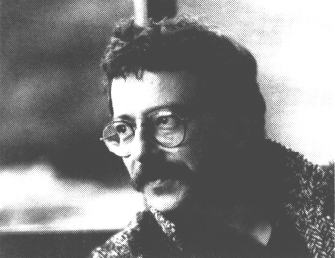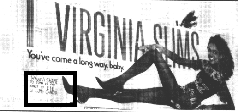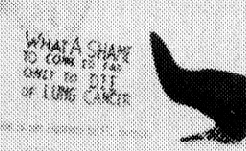

Spring 1992, Volume 1, Number 1
A publication of Citizens for Media Literacy, 34 Wall Street, Suite 407, Asheville, NC 28801
Copyright © 1992 by Citizens for Media Literacy, All Rights Reserved

Andrei Codrescu - poet, essayist and National Public Radio commentator - will headline a lecture series titled 'Whose First Amendment Is It, Anyway?" with a 7:15 p.m. talk Thursday, April 16 [1992] in Jubilee Community Center at 46 Wall Street in downtown Asheville.
The series of five lectures is sponsored by Citizens for Media Literacy and public radio station WCQS-FM. All lectures begin at 7:15 p.m. Admission is free. All lectures - except for April 24 - are held on consecutive Thursday evenings.
Codrescu's talk is entitled "Season of the Witch: Symbolism, Censorship and Sin - Reflections on the First Amendment." A native of Romania, Codrescu is a naturalized American citizen and professor of literature at Louisiana State University.
His books include "Raised by Puppets Only to be Killed by Research" and "The Hole in the Flag," which is based on his trips to Romania in 1989 and 1990.
"Whose First Amendment Is It, Anyway?" is designed to raise public awareness about the need for citizen involvement in protecting and upholding the U.S. Constitution's guarantee of "freedom of speech and the press, and the right of the people peaceably to assemble, and to petition the government for redress of grievances."
Other lectures in the series are:
April 23: "Secrets: How Government Keeps the Public From Knowing How Its Money is Spent" by Angus Mackenzie, director of the Media Alliance Freedom of Information Project and lecturer in the Graduate School of Journalism at the University of California at Berkeley. Mackenzie's talk is based on his forthcoming book from Farrar, Straus & Giroux by the same title.
April 24: "The Big Chill: Using Lawsuits to Intimidate Citizen Activists" by sociologist Penelope Canan who has studied more than 500 "SLAPP" suits (Strategic Lawsuits Against Public Participation). Canan is coeditor of the Political Litigation Project at the University of Denver.
* (Note: this is the only Friday night lecture in the series.)
April 30 "What Citizens Need to Know About the First Amendment" by Jane Kirtley, executive director of the Reporters' Committee for Freedom of the Press in Washington, DC. Kirtley is editor of the quarterly journal, 'The News Media and the Law," and is the author of "Shield Laws and Reporter's Privilege: A National Assessment."
May 7: "Voices of a Nation: Citizen Speech - Past, Present and Future" by Dwight L. Teeter, dean of the School of Journalism at the University of Tennessee and the 1991 Society of Professional Journalists' Distinguished Professor of the Year. Teeter is co-author of "Voices of a Nation: A History of the Media in the United States."
'Whose First Amendment Is It, Anyway?" will be broadcast live by public radio station WCQS-FM and offered on tape free of charge to National Public Radio affiliates nationwide.
Welcome to The New Citizen, a newsletter designed to promote effective citizenship in the age of mass media.
The New Citizen is published by Citizens for Media Literacy in Asheville, NC.
"Media literacy" acknowledges that a complex new "grammar" is evolving as our information environment - once dominated by the printed word - is increasingly dominated by the electronic world of images and sound.
Just as young basketball players learn to "read" the ever-changing flow of play in a fast-paced game, citizens with media literacy skills learn to "read" and navigate the complex and dynamic world of words. images and sounds.
Media literacy also requires a sophisticated understanding of the economic and cultural dynamics of the "business" of media.
For example, how do the commercial and entertainment demands of publishing and broadcasting shape the delivery of news and information?
How do the cultural relationships between reporters (who seek information) and their sources (officials who seek to shape public opinion) influence the news and information on which we base our citizenship activities?
Media literacy also raises important questions about free speech. For example, the idea of a "marketplace of ideas" - in which truth emerges from "uninhibited, robust and wide open" debate - has long been a pillar of First Amendment theory and practice.
But what happens when the decibel-level of some "voices" in the marketplace grows loud enough to drown out alternative voices and ideas? Many observers believe this future has already arrived with the increasing concentration of mass media ownership.
In the evolving world of First Amendment litigation and legislation, citizens must become informed and organized to insure that the public interest is served, not just in rhetoric, but in practice.
Our children are especially at risk in the world of TV and advertising. The image culture increasingly exposes children to adult themes and images in unprecedented ways, leading some researchers and critics to proclaim the "disappearance of childhood."
Citizens for Media Literacy is dedicated to helping parents, teachers and concerned citizens grapple with these issues. Our work is focused in three areas: children's issues, citizens' First Amendment rights, and public access to the media environment.
We welcome your comments and questions. Our address is 34 Wall Street, Suite 407, Asheville, NC 28801. Phone: 704-255-0182. Email: cml@unca.edu
Can TV news cover negative political ads without giving extra exposure to the ad's false claims?
Media researcher Kathleen Hall Jamieson says most TV news coverage of negative ads unwittingly repeats the ads' false claims. She suggests five steps for effective TV news coverage of negative ads.
Jamieson cautions reporters and news anchors to focus on "accuracy" and "facts" rather than "campaign strategy" during steps 1 and 5. Viewers often miss the accuracy critique when campaign strategy is emphasized, she says.
Legislation to re-regulate cable TV is likely to pass Congress this session and elude a threatened presidential veto, but rates for consumers will not be rolled back, predicts Jeff Chester, director of Ralph Nader's Teledemocracy Project.
The legislation authorizes the Federal Communications Commission to establish rate structures for all tiers of cable TV service, giving local governments a benchmark for negotiating rates with franchise-holders. Cable TV lobbyists, however, hope to limit FCC oversight to the basic tier, a low-end service which does not include popular channels such as CNN, ESPN, and the Discovery Channel.
Chester said the industry's clout is so strong in Congress and at the FCC that the legislation would do little more than bring rate increases in line with the cost-of-living index. The industry also has "a giant loophole" for increasing revenue via pay-per-view channels, an area of industry expansion that continues to be unregulated, Chester said.
The Campaign for Kids' TV is coming to Western North Carolina.
A project of Ralph Nader's Center for Media Education and the National PTA, the campaign is designed to help local communities use the Children's Television Act of 1990 to improve TV programming for children.
That law limits advertising in children's programming to 105 minutes per hour on weekends and 12 minutes per hour on weekdays, and it requires local stations to "serve the educational and informational needs of children."
"This new law creates an unprecedented window of opportunity for improving the variety and quality of programs viewed by America's 100 million children," said Jeffrey Chester, co-director of the Campaign for Kids' TV.
"But the Children's Television Act will not have a significant impact on children's programming unless there is widespread public involvement in its implementation."
Chester and his wife, media activist and author Kathryn Montgomery, have received a grant from the Mary Babcock Reynolds Foundation to take the campaign to five pilot communities nationwide. Raleigh-Durham is one of those communities. Chester and Montgomery have agreed to help set up a similar project in WNC to be coordinated by Citizens for Media Literacy.
CML will be contacting local PTA chapters to meet with Chester and Montgomery in a community forum in April or May. To get involved, call Citizens for Media Literacy at 704-255-0182.

Helping pre-school children cope with the awesome world of mass media is one of the most important acts of parenting one can perform.
Here's a few tips gleaned from my experience helping my four-year-old keep Ninja Turtles in perspective:
Teach children the concept of "story." Tell them that storytelling is one thing people do for fun. Whenever my son and I read a book, the first thing we do is look at the jacket blurb to see who the author is.
If the author is the mother of four who lives in a farmhouse in Vermont, we spend a few minutes talking about her life on the farm. Later on when my son is playing with his puzzle map of the United States, I'll remind him (or he will remind me!) of the woman who lives in Vermont.
Once children catch on to the idea of "authorship," their curiosity will compel them to want to know the "who" behind every story. Reminding them of how Toto in "The Wizard of Oz" pulled back the curtain to reveal the "author" of the Wizard is another way to teach this concept.
For the Ninja Turtle phenomenon, I clipped a newspaper feature story on Kevin Eastman and Peter Laird. My son and I talked about how these two guys from New England began drawing cartoons of turtles that people liked. Pretty soon Laird and Eastman went to a toy factory and had their cartoon stories turned into toys. Then they went to a movie studio and had their stories turned into movies.
One Sunday morning when my son was sifting through the slick and colorful newspaper coupons and ads, he found a picture of a new set of toys called "Karate Turtles." We took this discovery and talked about how someone took Kevin and Peter's story so that they too could sell lots of toys and make lots of money.
Grasping the idea of "story" can naturally lead to an understanding of "good" and "bad" stories. A good story, for example, might be one in which the characters treat each other with kindness, love and respect. A bad story might be one in which violence predominates and people hurt each other or treat each other with disrespect.
Finally, teaching children about storytelling empowers them to create their own stories, and it can renew a parent's dormant creativity. "Tell me a spooky story, Daddy" is one of the most delightful and challenging requests my son makes. I am often surprised at what emerges from my "adultified" imagination.
Citizens for Media Literacy has donated "Buy Me That A Kid's Survival Guide to TV Advertising" to public libraries and schools in WNC.
This 28-minute video is designed for children ages 4 to 12, and combines children's comments with behind-the-scenes looks at how TV commercials directed at children often exaggerate a product's performance.
Children watch more than 30,000 commercials and buy almost $80 billion in merchandise each year, according to the video's producers, Consumer's Union and Action for Children's TV.
To borrow the video for home, school or group showings, contact these public libraries: Black Mountain, Harris Media Center-Mars Hill College, Haywood County, Jackson County, Madison County, McDowell County, Murphy, Pack, Valdese, Watauga County, and West Asheville. Or call Citizens for Media Literacy at 704-255-0182.
Even if the Kennedy assassination files are opened, we may never know the truth about who killed the president. Conspiracy or not, the denial of public access to the investigation is part of a well-established tradition of secrecy in government.
Secrecy in government is justified on grounds of national security or public health, safety and welfare. The public, it is said, should be left out of the conversation for its own good.
Secrecy is not the only way to control the public agenda. Propaganda is another effective tool. Most Americans living today are children of the Cold War. We grew up learning that the word "propaganda" is a method of thought control used mainly by enemies of the United States. The command center for anti-American propaganda was the Kremlin, we were told.
Many of us remember that everything from feminism to fluoridated water, from Martin Luther King, Jr. to day-care for children - was once labeled part of the "international communist conspiracy." As ridiculous as such accusations sound today, and given the disintegration of the Soviet Union, it would be foolish to assume that propaganda no longer exists.
Indeed, since Webster's defines propaganda as "ideas, facts, or allegations spread deliberately to further one's cause or to damage an opposing cause," citizens in the mass media age would be prudent to assume that virtually all news and advertising today is a form of propaganda.
My journalist friends will flinch at the suggestion that news is propaganda. After all, journalists have rigorous training and traditions in "objective" reporting, the idea that virtually all taint of bias can be removed from news reporting.
But two recent revelations prove how difficult this ideal is to achieve. Last January, various news media - from The New York Times to CBS' "60 Minutes" - reported that an October, 1990 story that helped sway American public opinion toward going to war may have been planted by the Kuwaiti government with the help of a top Washington public relations firm run by Craig Fuller, a former top aide to George Bush.
The Hill & Knowlton firm received $8 million from the Kuwaiti government for a PR campaign to generate public support for U.S. military intervention in the Persian Gulf. The star witness in the campaign was a 15-year old girl named Nayirah, who tearfully told a Congressional hearing that Iraqi soldiers "took the incubators and left the children to die on the cold floor."
The story was repeated by President Bush and other members of Congress in support of the war, but Hill & Knowlton's involvement was not disclosed. Nor was it revealed that Nayirah, whose last name was withheld for security reasons at the time, is the daughter of Kuwait's ambassador to the United States.
Subsequent investigations by human rights groups and news organizations have been unable to substantiate the alleged atrocity. The New York-based Middle East Watch spent18 days visiting Kuwaiti hospitals and interviewing dozens of doctors and nurses. They found no evidence that Iraqi soldiers took babies from incubators.
Yet the U.S. media, apparently without the means to detect the lie, disseminated the propaganda - if that's what it was - to the American public. With the U.S. Congress consenting to war by only a slim margin, the incubator story may have been the decisive factor in sending the United States to war.
How can the media guard against such lies? Could more vigorous investigative reporting have uncovered the Hill & Knowlton connection and placed the incubator story in a more critical light?
The second revelation occurred Jan. 21 when "Frontline," the PBS documentary series, revealed that Rev. Sun Myung Moon's Unification Church was the silent financial backer of the American Freedom Coalition, a right-wing political action organization which sponsored pro-Desert Storm rallies in all 50 states.
The program also revealed that Moon has invested more than $1 billion in U.S. media properties - such as the Washington Times and World & I magazine - as well as high-tech computer industries, real estate, and dozens of other businesses, foundations and associations. Where does Moon get all his money? "Frontline" tracked much of it to one of the richest men in Japan, Ryoichi Sasakawa.
Pat Choate, author of "Agents of Influence," an examination of Japan's campaign to influence American politics, calls Sasakawa "a very right wing conservative" whose political pedigree goes back to 1939 when he flew to Italy to meet with Benito Mussolini, whom he called "the perfect fascist."
One issue high on the Moon-Sasakawa agenda is the continued "projection of American military power overseas," according to "Frontline." Their efforts to advance their agenda strike at the heart of the American political process.
During the 1988 presidential campaign, for example, the Moon-financed American Freedom Coalition distributed more than 30 million pieces of political literature, including a glossy voter scorecard, which White House aide Douglas Wead called "by far the slickest and finest produced (campaign) material. And when that doesn't cost you anything," added Wead, "and it is not charged against the campaign and is widely distributed to mailing lists across the country, that has a very important impact," he told "Frontline."
Oliver North's secret military campaign in Nicaragua also got a boost from Moon money. In March, 1985, according to "Frontline," North wrote a top secret memo proposing the formation of a private foundation called the Nicaraguan Freedom Fund. A few weeks later the Washington Times, which supported the Contra war against Nicaragua, announced the birth of the fund in a front-page editorial. It was later revealed that the Times contributed the first $100,000 to the fund.
When Oliver North was questioned by Congress about his role in aiding the Contras, the American Freedom Coalition came to North's defense and produced "Oliver North: Fight for Freedom," a video broadcast more than 600 times over 100 television stations. According to tax records reviewed by "Frontline," the video raised more than $3.2 million for AFC.
The American Freedom Coalition also produced and distributed a pro-Star Wars video entitled "One Incoming." Written by author Tom Clancy and narrated by Charlton Heston, the video made a strong case for funding
Ronald Reagan's Strategic Defense Initiative and was seen on more than 400 television stations, according to Daniel Graham, a former CIA official who sits on the AFC national policy board.
By using media such as the Washington Times and associations such as AFC to promote a political agenda, Moon and the Unification Church may be violating federal law. The Foreign Agents Registration Act was passed just before World War Two in response to concerns that German and Japanese interests in the United States were influencing American public opinion.
Moon has tried to influence other media as well by founding the World Media Association, which sponsors conferences and junkets for journalists from all over the world. In a 1984 interview with public station KQED, top Moon associate Bo Hi Pak said the WMA is one weapon in the "war of ideas (where) the battlefield is the human mind... in this war the entire thing will be mobilized, political means, social means, economical means and propagandistic means, and basically trying to take over the other person's mind. That is what the third world war is all about - the war of ideology."
Despite widespread evidence of Moon's Korean and Japanese ties, the U.S. Justice Department under Reagan and Bush has steadfastly refused to investigate Moon and his associates for possible violations of the Foreign Agents Registration Act, according to "Frontline."
How do we protect ourselves from propaganda and manipulation, whether its source is alien or homegrown, corporate or governmental? Stories such as the Savings & Loan scandal, BCCI, the Iran-Contra affair, the October Surprise, and the manipulation of public opinion during the Persian Gulf War suggest that journalists are ill-equipped to hold powerful interests accountable until long after the misdeeds are done and the perpetrators are out of office or protected by plea-bargains.
This is not what James Madison and others had in mind when they conceived the First Amendment as the public's guarantee to access to information necessary for true representative government. Citizenship in the age of secrecy and propaganda requires that we no longer look at the morning paper or the evening news with an innocent eye.
Wally Bowen is executive director of Citizens for Media Literacy.

Free speech by citizen activists is coming under attack via a new silencing technique called "SLAPP," an acronym for Strategic Lawsuit Against Public Participation.
SLAPPs are most often used by corporations. real estate developers. alleged polluters and even government officials, according to researchers at the University of Denver.
These litigants use civil lawsuits, or the threat of a lawsuit, to intimidate and silence opponents, the researchers say. Though citizens who are targets of SLAPPs usually prevail in court, the time, expense and stress involved in litigation is often sufficient to discourage citizen activism.
Take the case of Martha Howard, a retired social studies teacher in Hendersonville. In June, 1990, Ms. Howard sent a letter and petition with 35 signatures to billboard advertisers asking them to reconsider their use of outdoor advertising.
On Aug. 30, 1990, Asheville attorney Albert L. Sneed, Jr., sent a certified letter to Howard on behalf of his client, Summey Outdoor Advertising. The letter threatened Ms. Howard with a civil lawsuit because Summey "believes that your actions are undertaken to the end that (his) business will be totally destroyed."
Sneed contended that Howard's actions constituted a "campaign to interfere with the business contracts and business relationship of Summey Outdoor Advertising.... make no mistake about it," the letter concludes, "continued illegal activity will result in this matter being brought before the Courts."
The threat apparently worked. Howard stopped writing letters, and other signers of the petition said they would not sign another one, according to a statement by Howard to the Hendersonville Times-News last September.
Many SLAPPs allege defamation and harassment, as in the case of Betty Blake of Wantagh Woods, NY Blake was sued for $6.5 million when she protested - via petitions and candlelight vigils - a developer's plan to cut down oak trees for a building project. The developer eventually dropped the suit.
In a study of 228 SLAPP cases, the University of Denver researchers, sociologist Penelope Canan and law professor George Pring, found that defendants needed an average of 36 months to get the suits dismissed or to win at trial.
In one California suit, three homeowner groups and some private citizens were sued for $40 million by a developer after they successfully campaigned for a ballot referendum calling for a moratorium on land development. The suit took two years to litigate, during which time many citizens dropped out of the home owner groups. One defendant, however, chose to counter sue, charging violation of his First Amendment rights. He was awarded punitive damages of $260,000.
The SLAPP phenomenon has become so common that eight states are considering legislation to create judicial procedures that would allow judges to quickly dismiss SLAPPs when plaintiffs cannot establish a "substantial probability" that their suits will be successful.
Ralph Nader, meanwhile, is establishing a coalition to encourage citizens targeted by SLAPPs to counter sue based on First Amendment grounds. Joe Belluck, a law student at the State University of New York campus in Buffalo, is the coalition organizer.
Many citizens and organizations who get hit with SLAPPs don't understand the phenomenon, Belluck said. "Labeling them for what they are is a very important step in putting a stop to these frivolous suits. We hope to raise public awareness about SLAPPs and let people know that there's someone here to help them," he said.
Belluck is working to identify a national pool of volunteer attorneys to help SLAPP victims, and he hopes to have a national office set up within six months. Until then, interested citizens can write Belluck at the SLAPP Project, PO Box 19367, Washington, DC 20036.
Penelope Canan will discuss the SLAPP suit trend at 7:15 p.m., Friday, April 24 as part of CML's 'Whose First Amendment Is It, Anyway?" lecture series. See page one.
 |
 |
| Before | After |
|---|
As long as anyone can remember, the billboard at Biltmore Avenue and Hilliard Street has portrayed cigarette smoking as glamorous and fun.
For years, the 14 by 48 foot street-level sign, adjacent to Asheville's black business district and within a half mile of the city's hospitals, directed its message mainly at women and African-Americans. In January. for the first time in at least a decade. that message changed radically.
The billboard now carries the U.S. Surgeon General's warning about the hazards of smoking by pregnant women. Instead of being buried in small type at the bottom of the sign, the warning label is now spread in large white letters on a jet black background, filling all 672 square feet.
"We wanted to call attention to how the message environment influences our health for better or worse. Counter-ads are a good way to do that," said Wally Bowen, executive director of Citizens for Media Literacy, which purchased the billboard space.
Bowen said the stark white-on-black health warning on a billboard that for many years carried glamorous and colorful images is getting lots of attention. "We've had a lot of supportive phone calls. One parent even said his young children, who don't know how to read yet, commented on the change in imagery," he said.
Children are especially vulnerable to billboards because their exposure to outdoor messages can't be controlled by parents, said Bowen. This phenomenon is well-known to the tobacco industry, which gets as much as 90 percent of its $7.3 billion in annual revenue from smokers who became addicted as children, according to estimates by Action on Smoking and Health, a Washington, D.C.-based research and education organization.
"We chose the smoking and pregnant women message because we don't hear much about how children we hurt by smoking, directly or indirectly, and because this particular billboard has for years aimed its message at young women," Bowen said.
All citizens, smokers and non-smokers, are hurt by tobacco addiction via higher health care costs and lower job and school performance, he added.
CML was originally turned down by the billboard's owner, Naegele Outdoor Advertising, when the organization first tried to purchase space for its anti-smoking message last August. "We were told that the company would be biting the hand that feeds it if they allowed an anti-smoking message," said Bowen.
By November, however, the billboard company had changed its mind. Bowen believes the recession, cutbacks in tobacco advertising, and a desire to upgrade its public image are behind the company's change of heart.
"After having been turned down the first time, we weren't sure that we still wanted to purchase space. But when we learned that the tobacco industry had let its contract lapse on this particular location, we knew we had to do it," he said.
 |
[HTML Editors note: When scanning the original documents, the graffiti on the Virginia Slims billboard became illegible, so this digitally enhanced blow-up is included.] |
A billboard towering over a school yard shows an African-American man with his head buried in the chest of an African-American woman. It's an ad for Seagram's Gin. The tag line reads, "Everything they say is true."
Alcohol and tobacco companies routinely target the young, the poor, and racial and ethnic minorities. Here's an ad that aired on radio and TV last June: "Get your girl in the mood quicker and get your jimmy thicker with St. Ides Malt Liquor."
Communities across the nation are fighting back by passing local ordinances. protesting billboards. or boycotting offensive products. Even the U.S. Congress is considering hearings to investigate alcohol advertising practices targeting racial and ethnic communities.
Media literacy activists can help. The Marin Institute for the Prevention of Alcohol and Other Drug Problems is conducting a national petition drive to encourage congressional action.
Citizens for Media Literacy is helping the Marin Institute in this effort. If you want to add your name to the fight, call .Citizens for Media Literacy at 704-255-0182, and we will send you a simple endorsement form to fill out.
For more information about this national effort, call the Marin Institute at 415-456-5692, or write them at 24 Belvedere Street, San Rafael, Calif. 94901.
A lecture series sponsored by Citizens for Media Literacy and Public Radio WCQS.
All lectures will be held at 7:15 p.m. at Jubilee Community Center, 46 Wall Street, Asheville. Admission is free.
April 16 Andrei Codrescu, National Public Radio commentator
"The Season of the Witch: Symbolism, Censorship and Sin - Reflections on
the First Amendment"
April 23 Angus Mackenzie, investigative reporter and freedom of information
lecturer
"Secrets: How Government Keeps the Public From Knowing How Its Money is
Spent"
April 24 Penelope Canan, sociologist and co-director of the Political Litigation
Project
"The Big Chill: Using Lawsuits to Intimidate Citizen Activists"
April 30 Jane Kirtley, executive director of the Reporters' Committee for Freedom
of the Press
"What Citizens Need to Know About the First Amendment"
May 7 Dwight Teeter, press historian and Dean of the University of Tennessee's
School of Journalism
"Voices of a Nation: Citizen Free Speech, Past, Present, Future"
("The Big Chill" is the only lecture not held on Thursday evenings)